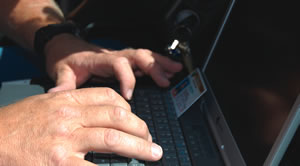 Many eyes have been focused on the nine Monroe County courts as they became the first in the state to use the Odyssey case management system (CMS). A less noticed but most effective consequence of the Odyssey deployment is the interface between Odyssey and the Supreme Court’s electronic Citation and Warning System (eCWS). This interface is already providing a double dose of improved efficiency for law enforcement, courts, clerks and the Indiana Bureau of Motor Vehicles (BMV).
Many eyes have been focused on the nine Monroe County courts as they became the first in the state to use the Odyssey case management system (CMS). A less noticed but most effective consequence of the Odyssey deployment is the interface between Odyssey and the Supreme Court’s electronic Citation and Warning System (eCWS). This interface is already providing a double dose of improved efficiency for law enforcement, courts, clerks and the Indiana Bureau of Motor Vehicles (BMV).
The eCWS is a collaborative project between the judicial and executive branches of state government, funded by federal grant funds, and spearheaded by the Supreme Court’s Judicial Technology and Automation Committee (JTAC) allowing law enforcement officers to use a hand-held scanner to read the bar code on a driver’s license and vehicle registration. The information then automatically populates a citation, and the data from the electronic ticket goes into a secure central repository—no handwriting, no double data entry.
The repository has a “Prosecutor’s screen” where a prosecutor can review the ticket and make a decision to proceed. The record is then sent to the court through Odyssey and a case number is generated automatically. An interface with ProsLink, the prosecuting attorneys’ case management system, is planned. The data remains the data of law enforcement until a law enforcement officer or prosecutor makes a discrete entry to “file” the case or transfer it to the Odyssey court system. Only at that time does the data become court data.
The interface allowing the ticket data to go to Odyssey creates a seamless process. There is no need for stacks of tickets to be delivered for inputting into a computer system. The Division of State Court Administration decided to assume a leadership role in this project because, ultimately, the traffic citations generated at the law enforcement level become a court record. Having consistent, accurate information, entered only once, from start to finish, is important to the courts.
Once the ticket information is sent electronically to the court, a case is created within the Odyssey CMS. A case number is assigned, and the information on the driver and the offense automatically appear in Odyssey, saving time and effort for staff.
Through a different federal grant, the Division of State Court Administration’s JTAC staff launched the “BMV project.” This project developed an automated application for the electronic transmission of traffic case decisions to the Bureau of Motor Vehicles (BMV). State statutes require that traffic case decisions be transmitted to the BMV on a special form, called “SR-16.”
With the electronic issuance of traffic citations, the electronic filing of the cases in the Odyssey CMS, and the electronic transmission of SR-16 forms to the BMV, Indiana has at its fingertips a true end-to-end solution for traffic cases.
In Monroe County, law enforcement officers in the County Sheriff’s Department, as well as police departments in Ellettsville, Stinesville, Bloomington, and at Indiana University are all using eCWS.
Since these departments began using eCWS in December 2007, more than 2,800 e-tickets have been issued and sent electronically to Odyssey.
As eCWS and Odyssey are deployed statewide, the impact of the interface between the two and with the BMV will have unprecedented impact on the way Indiana’s traffic citation cases are processed and recorded. More than 700,000 traffic citations are issued each year in Indiana, and eventually the vast majority will be filed in a court, will be assigned case numbers, and will be tracked automatically in Odyssey. This end-to-end solution will improve accuracy, save time and promote public safety.